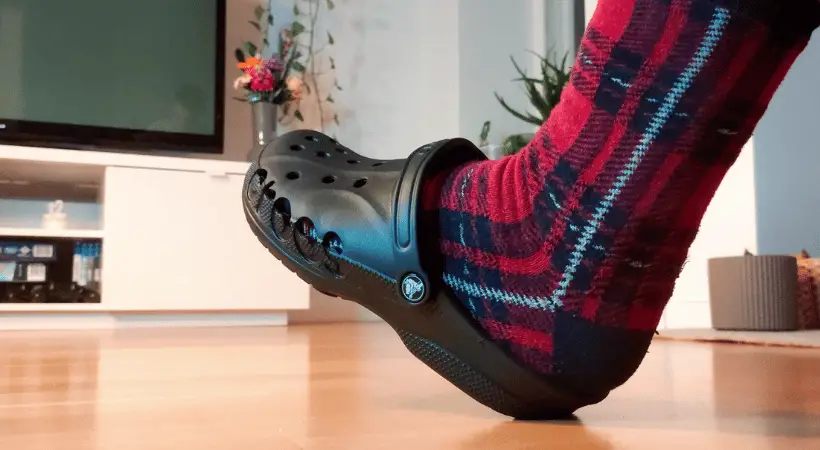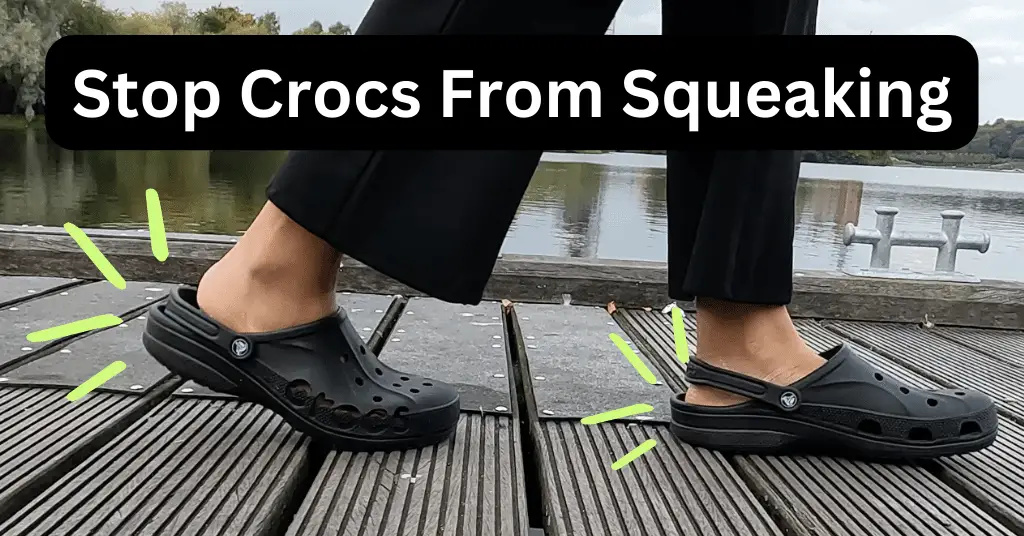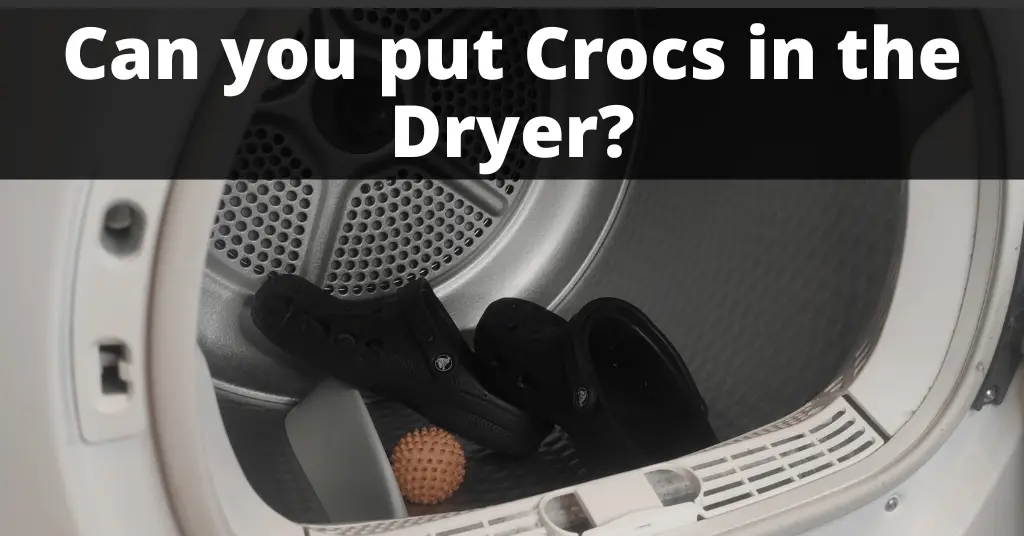Crocs, while known for their comfort and versatility, can sometimes produce an irritating squeaking sound. This noise isn’t just a bother to the wearer, but it can also be a distraction to those around you, whether you’re at work, socializing, or simply taking a stroll. So, it’s essential to tackle this issue head-on for a noise-free and enjoyable Crocs experience.
Often, this squeaking arises from the friction between your foot and the shoe. A simple remedy? Try wearing socks. For more lasting solutions, think about using lubricants or even reshaping your Crocs for a snugger fit.
In this article, we’ll delve into these solutions with detailed instructions.
Understanding the Causes of Crocs Squeaking
Crocs are fashioned from a distinctive material known as Croslite. This unique closed-cell resin foam boasts both lightweight and water-resistant qualities, making it a popular choice for a variety of outdoor activities. Its inherent properties, filled with tiny air bubbles, offer users an exceptional cushioning experience and heightened comfort. However, there’s a downside to this structure: it can lead to the shoes squeaking due to friction.
How the Crocs fit the wearer also plays a pivotal role in the noise’s occurrence. If the Crocs fit too loosely, the foot can slide and create additional friction, leading to more pronounced squeaking. Conversely, if they are too snug, the foot might constantly rub against the shoe’s material, leading to similar noisy consequences.
The presence of moisture complicates matters. Whether it originates from sweat or from external wet surfaces, moisture can both mitigate and exacerbate the squeaking phenomenon. A moderate amount of moisture can act as a buffer, reducing friction and thus the likelihood of noise. However, if the Crocs lack proper ventilation and there’s an excessive accumulation of moisture, it can lead to even more pronounced friction and consequently, more squeaking.
Identifying the Different Types of Crocs Squeaking
Crocs squeaking can vary in intensity and frequency, and understanding the different types of squeaking can help in identifying the underlying causes and finding effective solutions. By categorizing the squeaking sounds, we can better address the specific issues that contribute to the annoyance.
- High-pitched Squeaking: This sharp sound usually comes from friction between your foot and new or glossy Crocs.
- Low-frequency Squeaking: This deeper sound is often due to moisture trapped inside, creating a suction effect when walking.
The cause of high-pitched squeaking is usually the foot rubbing against the shoe’s material. Adjusting the fit or using lubricants can help. For the low-frequency kind, it’s about moisture. Changing insoles, using baby powder, or treating the Crocs with heat can reduce the sound.
Let’s discuss these solutions in depth.
Practical Solutions to Stop Crocs from Squeaking
Let’s explore different methods in depth to address the issue of Crocs squeaking with step-by-step instructions for each solution. By implementing these techniques, you can enjoy your Crocs without the distracting noise.
1. Wearing socks

Before diving into intricate solutions or investing time in fixes, sometimes the simplest remedy can make all the difference. One such straightforward approach to counteract squeaking in Crocs is just to wear socks with them.
The primary cause of squeaking in shoes, including Crocs, is often friction between the foot and the shoe’s material. Socks can act as a barrier, reducing this friction and thereby minimizing or even eliminating the squeak.
Furthermore, sweaty feet will also increase the likelihood of squeaking. Socks, especially those made of breathable materials like cotton, can absorb moisture, keeping your feet dry and lessening the chance of squeaky sounds.
2. Adjusting the Fit
Most of the time friction occurs due to an improper fit. When they are either too loose or too tight on your feet, it can create friction between your foot and the shoe, resulting in a squeaking noise. Luckily, there are some options for you to take.
If your Crocs are too loose:
- Consider using heel straps or backstraps to secure your feet in place.
- Try shrinking your Crocs down by size (follow our tips for concrete Crocs shrinking methods.)
If your Crocs are too tight:
- Remove any additional insoles or inserts that may be causing the tightness.
- Try unshrinking your Crocs by first heating them up and then stretching them out to a more comfortable fit (choose your preferred method from our Crocs unshrinking guide.)
By carefully adjusting the fit of your Crocs, you can minimize friction and reduce squeaking significantly.
3. Using Talcum Powder or Baby Powder
Another simple yet highly effective method to tackle the squeaky sound in your Crocs is using talcum powder or baby powder. This age-old trick can be a game-changer for many footwear woes.
Talcum powder acts as a lubricant, reducing friction between the shoe and your foot. It also absorbs any moisture, a common culprit behind that irritating squeak, especially in humid conditions.
Here’s how to apply this technique:
- Clean Your Crocs: Make sure your Crocs are clean and dry. This ensures the maximum efficiency of the powder.
- Apply the Powder: Lightly sprinkle talcum or baby powder inside your Crocs, especially focusing on the footbed where your foot makes the most contact.
- Spread Evenly: Gently tap the sides of your Crocs to spread the powder evenly. You can also use your hands to ensure an even distribution.
- Wear Your Crocs: Put on your Crocs and walk around a bit. The movement allows the powder to further spread and seep into potential friction spots.
- Excess Powder: If you notice any excess powder coming out as you walk, simply shake it off or tap the Crocs upside down.
- Regular Application: Depending on the level of use and humidity, you may need to reapply the powder periodically.
4. Applying Vaseline or Lubricants
Another effective solution to stop Crocs from squeaking is the application of lubricants. Lubricants help reduce friction between the foot and the shoe, eliminating the squeaking sound. However, it is essential to choose the right lubricant to avoid damaging the Crocs’ materials.
Silicone-based lubricants are the most recommended option as they provide excellent lubrication without causing any harm. Avoid using oil-based lubricants, as they can leave stains and compromise the integrity of the Crocs’ material.
To apply lubricants to your Crocs, follow these steps:
- Clean your Crocs pair thoroughly with mild soap and water to remove any dirt or debris.
- Dry the Crocs completely before applying the lubricant.
- Apply a small amount of silicone-based lubricant to the areas where friction occurs, such as the footbed or straps.
- Spread the lubricant evenly with a clean cloth or your fingers, ensuring it covers the necessary areas.
- Allow the Crocs to air dry for a few minutes before wearing them.
5. Modifying the Insole
If you have insoles in your Crocs, those will play a significant role in the squeaking issue. If the insole is worn out or damaged, it can create friction and cause annoying noise. Modifying the insole can provide a simple yet effective solution to this problem.
Consider replacing the existing insole with a new one. Look for insoles made of materials that reduce friction, such as gel or memory foam. These materials can absorb shock and provide additional cushioning, reducing the chances of squeaking.
Furthermore, you can add anti-slip or anti-squeak inserts. These inserts are specifically designed to reduce friction and eliminate squeaking. They can be easily placed on top of the existing insole, providing an immediate solution to the problem.
6 Breaking Them In
Fresh out of the box, your brand-new Crocs may be a tad bit squeaky. Just like a pair of formal shoes or new sneakers, Crocs too can benefit from a good ol’ breaking-in session.
New Crocs haven’t yet had the chance to adjust to the unique contours of your feet. The initial stiffness of the material combined with any potential minor manufacturing inconsistencies can result in some unexpected noises.
Here’s how to break in your Crocs effectively:
- Start Slow: Don’t wear your new Crocs for a full day immediately. Start by wearing them around the house for short durations. This allows the material to begin adjusting to your feet without the stress of outdoor wear and tear.
- Soft Steps: While you’re at home, walk around on carpeted areas or soft surfaces. This gently introduces your Crocs to the movement and pressure of walking.
- Flex and Bend: Every now and then, take off your Crocs and gently bend and flex them. This softens the material, especially in places that might be causing friction.
- Increase Wear Time: Gradually increase the amount of time you wear your Crocs over several days. As they get more comfortable and the material softens, the squeaking will likely reduce.
- Stay Patient: Remember, breaking in shoes is a process. It might take a few days or even a week depending on the specific pair and how often you wear them.
By investing some time into breaking in your Crocs, you’re not just working towards silencing them, but also ensuring they’ll be a comfortable fit for the long run.
7. Treating the Crocs with Heat

As we have mentioned above, applying heat will make your Crocs pliable which allows you to modify their size and shape. In fact, even if they fit well, you can still refine the fit without damage. So if you don’t feel like working towards breaking your Crocs in, this is a great option for you.
The heat softens the material, helping it adapt better to your foot shape, thus decreasing squeaks. My favourite method to heat Crocs up to the malleable temperature is using a tumble dryer. Here’s a safe way to approach this:
- Place 2 damp towels inside the dryer.
- Now put your Crocs pair inside.
- Set the highest heating setting and start the dryer for 10 minutes
- Once finished, carefully take your Crocs out and immediately put them on (For safety and a lose fit, try wearing socks or even double up depending on your preference).
- Walk around for a few minutes, letting them form to your feet
- Once Crocs cool down, they will retain the new shape.
- Repeat the process if necessary.
8. Professional Shoe Repair Services
While most Crocs-related squeaks can be fixed using DIY methods, there might be instances where you’re left scratching your head, unable to pinpoint or resolve the source of the noise. In such cases, it’s time to consider calling in the pros.
For some it might seem a bit much for a pair of Crocs, if they’re your favorite pair or have sentimental value, getting them to a professional can ensure they last longer and stay squeak-free. It’s an investment in ensuring comfort and peace with every step.
Preventative Measures to Avoid Crocs Squeaking
While the solutions mentioned above are effective in stopping Crocs from squeaking, it is always better to prevent the issue from occurring in the first place. By taking proper care and following preventative measures, you can avoid the frustration of squeaky Crocs.
To prevent squeaking, consider the following care and maintenance tips for your Crocs:
- Regularly clean your Crocs to remove dirt and debris that may contribute to friction.
- Allow your pair to dry completely before wearing them, especially if they have been exposed to moisture.
- Store your Crocs in a cool and dry place to avoid excessive humidity.
Incorporate these preventative measures into your Crocs care routine, and you will minimize the chances of squeaking significantly.


